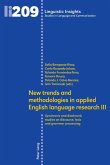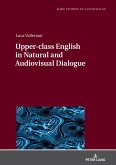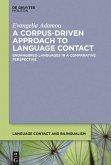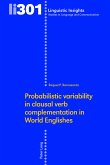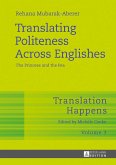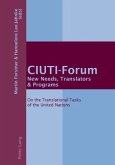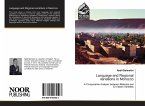Iván TamaredoPronoun Omission in World Englishes
Complexity, Efficiency, and Language Contact
Pronoun Omission in World Englishes
Herausgegeben:Gotti, Maurizio
Iván TamaredoPronoun Omission in World Englishes
Complexity, Efficiency, and Language Contact
Pronoun Omission in World Englishes
Herausgegeben:Gotti, Maurizio
- Gebundenes Buch
- Merkliste
- Auf die Merkliste
- Bewerten Bewerten
- Teilen
- Produkt teilen
- Produkterinnerung
- Produkterinnerung
The book provides an assessment of the contribution of pronoun omission to the complexity and efficiency of varieties of English and the influence of language contact on its attestation and pervasiveness. On the one hand, omitted pronouns result in simpler and more efficient structures, provided their antecedents are retrievable from the context. On the other hand, the choice between overt and omitted pronouns depends on several grammatical constraints, which in turn may entail an increase in system complexity. Two methodologically different but complementary case studies are presented, which…mehr
Andere Kunden interessierten sich auch für
![New trends and methodologies in applied English language research III New trends and methodologies in applied English language research III]() New trends and methodologies in applied English language research III105,15 €
New trends and methodologies in applied English language research III105,15 €![Upper-class English in Natural and Audiovisual Dialogue Upper-class English in Natural and Audiovisual Dialogue]() Luca VallerianiUpper-class English in Natural and Audiovisual Dialogue44,50 €
Luca VallerianiUpper-class English in Natural and Audiovisual Dialogue44,50 €![A Corpus-Driven Approach to Language Contact A Corpus-Driven Approach to Language Contact]() Evangelia AdamouA Corpus-Driven Approach to Language Contact94,99 €
Evangelia AdamouA Corpus-Driven Approach to Language Contact94,99 €![Probabilistic variability in clausal verb complementation in World Englishes Probabilistic variability in clausal verb complementation in World Englishes]() Raquel P. RomasantaProbabilistic variability in clausal verb complementation in World Englishes86,95 €
Raquel P. RomasantaProbabilistic variability in clausal verb complementation in World Englishes86,95 €![Translating Politeness Across Englishes Translating Politeness Across Englishes]() Rehana Mubarak-AbererTranslating Politeness Across Englishes44,25 €
Rehana Mubarak-AbererTranslating Politeness Across Englishes44,25 €![CIUTI-Forum- New Needs, Translators & Programs CIUTI-Forum- New Needs, Translators & Programs]() CIUTI-Forum- New Needs, Translators & Programs81,70 €
CIUTI-Forum- New Needs, Translators & Programs81,70 €![Language and Regional variations in Morocco Language and Regional variations in Morocco]() Nabil BelmekkiLanguage and Regional variations in Morocco15,99 €
Nabil BelmekkiLanguage and Regional variations in Morocco15,99 €-
-
-
The book provides an assessment of the contribution of pronoun omission to the complexity and efficiency of varieties of English and the influence of language contact on its attestation and pervasiveness. On the one hand, omitted pronouns result in simpler and more efficient structures, provided their antecedents are retrievable from the context. On the other hand, the choice between overt and omitted pronouns depends on several grammatical constraints, which in turn may entail an increase in system complexity. Two methodologically different but complementary case studies are presented, which contribute new findings to the literature at the crossroads of research on World Englishes, complexity, efficiency, and pronoun omission.
Produktdetails
- Produktdetails
- Linguistic Insights 270
- Verlag: Peter Lang
- Artikelnr. des Verlages: 433902
- Seitenzahl: 292
- Erscheinungstermin: 2. April 2020
- Englisch
- Abmessung: 231mm x 155mm x 20mm
- Gewicht: 487g
- ISBN-13: 9783034339025
- ISBN-10: 303433902X
- Artikelnr.: 59162637
- Herstellerkennzeichnung Die Herstellerinformationen sind derzeit nicht verfügbar.
- Linguistic Insights 270
- Verlag: Peter Lang
- Artikelnr. des Verlages: 433902
- Seitenzahl: 292
- Erscheinungstermin: 2. April 2020
- Englisch
- Abmessung: 231mm x 155mm x 20mm
- Gewicht: 487g
- ISBN-13: 9783034339025
- ISBN-10: 303433902X
- Artikelnr.: 59162637
- Herstellerkennzeichnung Die Herstellerinformationen sind derzeit nicht verfügbar.
Iván Tamaredo holds a PhD in English studies from the University of Santiago de Compostela (Spain). His research interests include varieties of English, probabilistic variation, language processing, and linguistic complexity.
List of abbreviations .......................................................................... 11
1 Introduction ................................................................................. 15
1.1 Communicative efficiency and language complexity .......... 15
1.2 Aims and research questions ............................................... 18
1.3 Structure of the book ........................................................... 21
2 Language complexity .................................................................. 25
2.1 Historical background ......................................................... 26
2.2 Sources of complexity variance ........................................... 31
2.2.1 Language contact ...................................................... 32
2.2.2 Acquisition versus use .............................................. 35
2.2.3 A typology of contact situations ............................... 38
2.2.4 Additional social determinants of complexity .......... 40
2.3 Measuring complexity ......................................................... 41
2.3.1 Kusters (2003, 2008) ................................................ 42
2.3.2 Miestamo (2006a, 2008) ........................................... 44
2.3.3 Hawkins (1994, 2004, 2009, 2014) .......................... 45
2.3.4 Comparison between the three metrics ..................... 48
2.3.5 Some important distinctions ..................................... 52
2.4 Complexity and varieties of English ................................... 55
3 Pronoun omission ........................................................................ 63
3.1 Generative approaches ......................................................... 65
3.2 Cognitive approaches .......................................................... 69
3.2.1 Agreement and context ............................................. 69
3.2.2 Accessibility theory .................................................. 73
3.2.3 Further factors .......................................................... 76
3.3 Pronoun omission in English ............................................... 79
3.3.1 Pronoun omission in the history of British English ..... 82
3.3.2 Constraints in Present-day English ........................... 84
3.4 The complexity and efficiency of pronoun omission .......... 90
4 A cross-varietal study of pronoun omission in English ............... 97
4.1 Simplification and substrate effects ................................... 100
4.2 Data and methodology ....................................................... 103
4.3 Results ............................................................................... 109
4.3.1 Global indexes: pronoun omission attestation and pervasiveness .......................................................... 109
4.3.2 Attestation and pervasiveness of individual features ................................................................... 117
4.4 Simplification and substrate effects revisited .................... 124
5 Complexity variance in English: pronoun omission and language contact ........................................................................ 129
5.1 Aims and purpose of the study .......................................... 130
5.2 Data and methodology ....................................................... 133
5.2.1 Corpus and data retrieval process ........................... 133
5.2.2 Varieties selected .................................................... 137
5.2.3 Variables included in the analysis ........................... 139
5.2.3.1 Language-external constraints ................... 140
5.2.3.2 Language-internal constraints ................... 141
5.2.3.3 Interim summary ....................................... 151
5.2.4 Statistical analysis .................................................. 152
5.2.4.1 Regression modelling and structural complexity ................................................. 153
5.2.4.2 Random forests and system complexity .... 155
5.3 Frequency of omitted and overt pronouns per variety ....... 157
5.3.1 Results .................................................................... 157
5.3.2 Discussion .............................................................. 170
5.4 Multivariate analysis of the data ........................................ 175
5.4.1 Structural complexity ............................................. 175
5.4.1.1 Results ....................................................... 175
5.4.1.2 Discussion ................................................. 190
5.4.2 System complexity ................................................. 193
5.4.2.1 Results ....................................................... 193
5.4.2.2 Discussion ................................................. 197
5.5 Complexity and contact revisited ...................................... 199
6 Concluding remarks and suggestions for further research ........ 203
Appendix .......................................................................................... 213
List of figures ................................................................................... 247
List of tables ..................................................................................... 249
References and sources .................................................................... 253
1 Introduction ................................................................................. 15
1.1 Communicative efficiency and language complexity .......... 15
1.2 Aims and research questions ............................................... 18
1.3 Structure of the book ........................................................... 21
2 Language complexity .................................................................. 25
2.1 Historical background ......................................................... 26
2.2 Sources of complexity variance ........................................... 31
2.2.1 Language contact ...................................................... 32
2.2.2 Acquisition versus use .............................................. 35
2.2.3 A typology of contact situations ............................... 38
2.2.4 Additional social determinants of complexity .......... 40
2.3 Measuring complexity ......................................................... 41
2.3.1 Kusters (2003, 2008) ................................................ 42
2.3.2 Miestamo (2006a, 2008) ........................................... 44
2.3.3 Hawkins (1994, 2004, 2009, 2014) .......................... 45
2.3.4 Comparison between the three metrics ..................... 48
2.3.5 Some important distinctions ..................................... 52
2.4 Complexity and varieties of English ................................... 55
3 Pronoun omission ........................................................................ 63
3.1 Generative approaches ......................................................... 65
3.2 Cognitive approaches .......................................................... 69
3.2.1 Agreement and context ............................................. 69
3.2.2 Accessibility theory .................................................. 73
3.2.3 Further factors .......................................................... 76
3.3 Pronoun omission in English ............................................... 79
3.3.1 Pronoun omission in the history of British English ..... 82
3.3.2 Constraints in Present-day English ........................... 84
3.4 The complexity and efficiency of pronoun omission .......... 90
4 A cross-varietal study of pronoun omission in English ............... 97
4.1 Simplification and substrate effects ................................... 100
4.2 Data and methodology ....................................................... 103
4.3 Results ............................................................................... 109
4.3.1 Global indexes: pronoun omission attestation and pervasiveness .......................................................... 109
4.3.2 Attestation and pervasiveness of individual features ................................................................... 117
4.4 Simplification and substrate effects revisited .................... 124
5 Complexity variance in English: pronoun omission and language contact ........................................................................ 129
5.1 Aims and purpose of the study .......................................... 130
5.2 Data and methodology ....................................................... 133
5.2.1 Corpus and data retrieval process ........................... 133
5.2.2 Varieties selected .................................................... 137
5.2.3 Variables included in the analysis ........................... 139
5.2.3.1 Language-external constraints ................... 140
5.2.3.2 Language-internal constraints ................... 141
5.2.3.3 Interim summary ....................................... 151
5.2.4 Statistical analysis .................................................. 152
5.2.4.1 Regression modelling and structural complexity ................................................. 153
5.2.4.2 Random forests and system complexity .... 155
5.3 Frequency of omitted and overt pronouns per variety ....... 157
5.3.1 Results .................................................................... 157
5.3.2 Discussion .............................................................. 170
5.4 Multivariate analysis of the data ........................................ 175
5.4.1 Structural complexity ............................................. 175
5.4.1.1 Results ....................................................... 175
5.4.1.2 Discussion ................................................. 190
5.4.2 System complexity ................................................. 193
5.4.2.1 Results ....................................................... 193
5.4.2.2 Discussion ................................................. 197
5.5 Complexity and contact revisited ...................................... 199
6 Concluding remarks and suggestions for further research ........ 203
Appendix .......................................................................................... 213
List of figures ................................................................................... 247
List of tables ..................................................................................... 249
References and sources .................................................................... 253
List of abbreviations .......................................................................... 11
1 Introduction ................................................................................. 15
1.1 Communicative efficiency and language complexity .......... 15
1.2 Aims and research questions ............................................... 18
1.3 Structure of the book ........................................................... 21
2 Language complexity .................................................................. 25
2.1 Historical background ......................................................... 26
2.2 Sources of complexity variance ........................................... 31
2.2.1 Language contact ...................................................... 32
2.2.2 Acquisition versus use .............................................. 35
2.2.3 A typology of contact situations ............................... 38
2.2.4 Additional social determinants of complexity .......... 40
2.3 Measuring complexity ......................................................... 41
2.3.1 Kusters (2003, 2008) ................................................ 42
2.3.2 Miestamo (2006a, 2008) ........................................... 44
2.3.3 Hawkins (1994, 2004, 2009, 2014) .......................... 45
2.3.4 Comparison between the three metrics ..................... 48
2.3.5 Some important distinctions ..................................... 52
2.4 Complexity and varieties of English ................................... 55
3 Pronoun omission ........................................................................ 63
3.1 Generative approaches ......................................................... 65
3.2 Cognitive approaches .......................................................... 69
3.2.1 Agreement and context ............................................. 69
3.2.2 Accessibility theory .................................................. 73
3.2.3 Further factors .......................................................... 76
3.3 Pronoun omission in English ............................................... 79
3.3.1 Pronoun omission in the history of British English ..... 82
3.3.2 Constraints in Present-day English ........................... 84
3.4 The complexity and efficiency of pronoun omission .......... 90
4 A cross-varietal study of pronoun omission in English ............... 97
4.1 Simplification and substrate effects ................................... 100
4.2 Data and methodology ....................................................... 103
4.3 Results ............................................................................... 109
4.3.1 Global indexes: pronoun omission attestation and pervasiveness .......................................................... 109
4.3.2 Attestation and pervasiveness of individual features ................................................................... 117
4.4 Simplification and substrate effects revisited .................... 124
5 Complexity variance in English: pronoun omission and language contact ........................................................................ 129
5.1 Aims and purpose of the study .......................................... 130
5.2 Data and methodology ....................................................... 133
5.2.1 Corpus and data retrieval process ........................... 133
5.2.2 Varieties selected .................................................... 137
5.2.3 Variables included in the analysis ........................... 139
5.2.3.1 Language-external constraints ................... 140
5.2.3.2 Language-internal constraints ................... 141
5.2.3.3 Interim summary ....................................... 151
5.2.4 Statistical analysis .................................................. 152
5.2.4.1 Regression modelling and structural complexity ................................................. 153
5.2.4.2 Random forests and system complexity .... 155
5.3 Frequency of omitted and overt pronouns per variety ....... 157
5.3.1 Results .................................................................... 157
5.3.2 Discussion .............................................................. 170
5.4 Multivariate analysis of the data ........................................ 175
5.4.1 Structural complexity ............................................. 175
5.4.1.1 Results ....................................................... 175
5.4.1.2 Discussion ................................................. 190
5.4.2 System complexity ................................................. 193
5.4.2.1 Results ....................................................... 193
5.4.2.2 Discussion ................................................. 197
5.5 Complexity and contact revisited ...................................... 199
6 Concluding remarks and suggestions for further research ........ 203
Appendix .......................................................................................... 213
List of figures ................................................................................... 247
List of tables ..................................................................................... 249
References and sources .................................................................... 253
1 Introduction ................................................................................. 15
1.1 Communicative efficiency and language complexity .......... 15
1.2 Aims and research questions ............................................... 18
1.3 Structure of the book ........................................................... 21
2 Language complexity .................................................................. 25
2.1 Historical background ......................................................... 26
2.2 Sources of complexity variance ........................................... 31
2.2.1 Language contact ...................................................... 32
2.2.2 Acquisition versus use .............................................. 35
2.2.3 A typology of contact situations ............................... 38
2.2.4 Additional social determinants of complexity .......... 40
2.3 Measuring complexity ......................................................... 41
2.3.1 Kusters (2003, 2008) ................................................ 42
2.3.2 Miestamo (2006a, 2008) ........................................... 44
2.3.3 Hawkins (1994, 2004, 2009, 2014) .......................... 45
2.3.4 Comparison between the three metrics ..................... 48
2.3.5 Some important distinctions ..................................... 52
2.4 Complexity and varieties of English ................................... 55
3 Pronoun omission ........................................................................ 63
3.1 Generative approaches ......................................................... 65
3.2 Cognitive approaches .......................................................... 69
3.2.1 Agreement and context ............................................. 69
3.2.2 Accessibility theory .................................................. 73
3.2.3 Further factors .......................................................... 76
3.3 Pronoun omission in English ............................................... 79
3.3.1 Pronoun omission in the history of British English ..... 82
3.3.2 Constraints in Present-day English ........................... 84
3.4 The complexity and efficiency of pronoun omission .......... 90
4 A cross-varietal study of pronoun omission in English ............... 97
4.1 Simplification and substrate effects ................................... 100
4.2 Data and methodology ....................................................... 103
4.3 Results ............................................................................... 109
4.3.1 Global indexes: pronoun omission attestation and pervasiveness .......................................................... 109
4.3.2 Attestation and pervasiveness of individual features ................................................................... 117
4.4 Simplification and substrate effects revisited .................... 124
5 Complexity variance in English: pronoun omission and language contact ........................................................................ 129
5.1 Aims and purpose of the study .......................................... 130
5.2 Data and methodology ....................................................... 133
5.2.1 Corpus and data retrieval process ........................... 133
5.2.2 Varieties selected .................................................... 137
5.2.3 Variables included in the analysis ........................... 139
5.2.3.1 Language-external constraints ................... 140
5.2.3.2 Language-internal constraints ................... 141
5.2.3.3 Interim summary ....................................... 151
5.2.4 Statistical analysis .................................................. 152
5.2.4.1 Regression modelling and structural complexity ................................................. 153
5.2.4.2 Random forests and system complexity .... 155
5.3 Frequency of omitted and overt pronouns per variety ....... 157
5.3.1 Results .................................................................... 157
5.3.2 Discussion .............................................................. 170
5.4 Multivariate analysis of the data ........................................ 175
5.4.1 Structural complexity ............................................. 175
5.4.1.1 Results ....................................................... 175
5.4.1.2 Discussion ................................................. 190
5.4.2 System complexity ................................................. 193
5.4.2.1 Results ....................................................... 193
5.4.2.2 Discussion ................................................. 197
5.5 Complexity and contact revisited ...................................... 199
6 Concluding remarks and suggestions for further research ........ 203
Appendix .......................................................................................... 213
List of figures ................................................................................... 247
List of tables ..................................................................................... 249
References and sources .................................................................... 253


